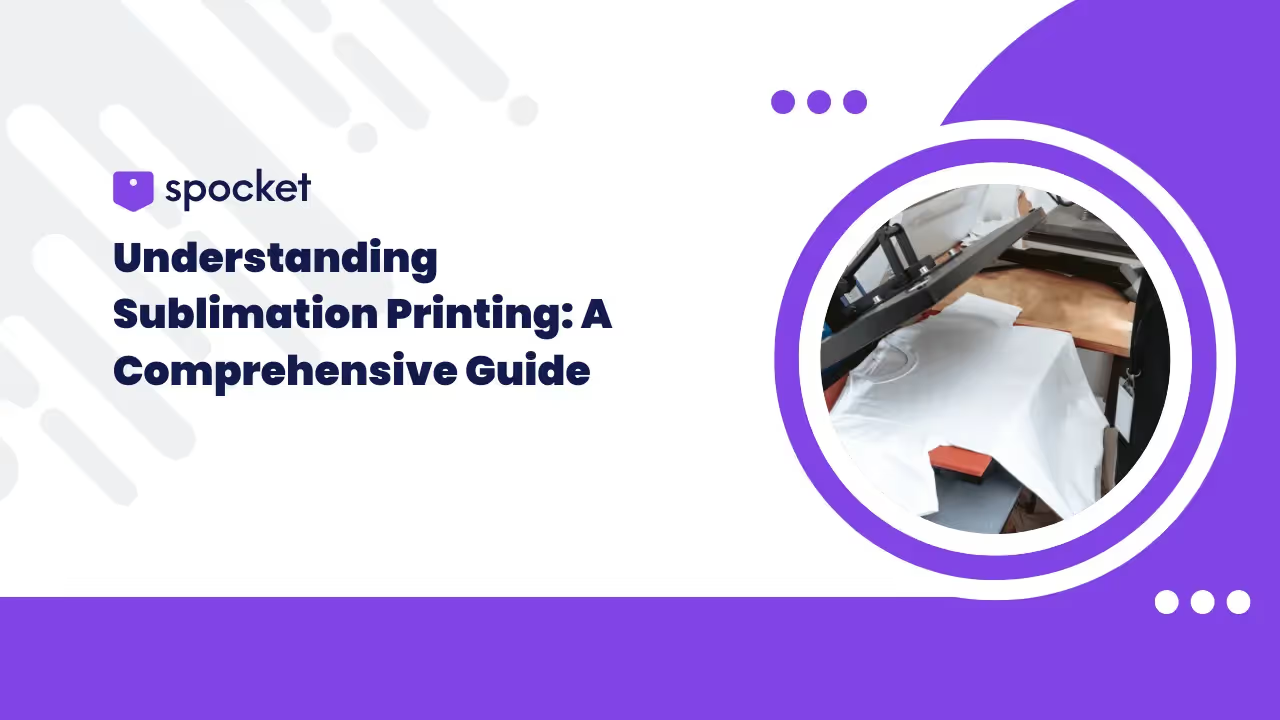The quality and uniqueness of your products play a pivotal role in attracting eyes and encouraging clicks.
Whether you're aiming to update your existing collection or launch new, attention-grabbing items, selecting the right printing methods can make a significant difference in creating merchandise that truly stands out.
In this blog post, we will cover the fundamentals of sublimation printing, detailing its process and the benefits it provides over other printing techniques. We’ll also look at the materials compatible with sublimation printing and address frequently asked questions. By the end, you’ll have a comprehensive understanding of sublimation printing and why it’s an excellent choice.
What is Sublimation Printing
Sublimation printing is a versatile and high-quality printing method that has surged in popularity across various industries.
Sublimation printing is a process that uses high heat and pressure to transfer a design from sublimation paper directly onto the chosen product (material or fabric). The combination of pressure and heat embeds the artwork into the product, ensuring vibrant and durable results.
Unlike conventional printing methods where ink is applied directly onto the surface, sublimation involves converting the dye into a gas without passing through a liquid state. This process allows the dye to penetrate the material and create a permanent, vibrant bond.
How Sublimation Printing Works
Materials Required:
- A digital design: An image or graphic that is required to be printed on the material.
- Sublimation Printer: A specialized printer equipped with sublimation ink, designed to produce high-quality, detailed prints.
- Sublimation Ink: Dye-based ink that can sublimate, or turn into gas, when heated.
- Transfer Paper: Special paper designed to hold sublimation ink temporarily before transferring it to the substrate.
- Heat Press: A machine that applies the necessary heat and pressure to transfer the dye from the paper to the substrate.
- Substrate: The material being printed on, which must have a polyester coating or be made of polyester for effective dye penetration.
The Sublimation Process:
- Design Creation:
The process begins with designing the image or graphic using graphic design software. This design is then mirrored before printing, as the transfer process will reverse the image.
- Printing the Design:
The mirrored design is printed onto the sublimation transfer paper using a sublimation printer loaded with sublimation ink. The ink is printed as a solid on the transfer paper but will turn into a gas when heated.
- Preparing the Substrate:
The substrate must be clean and dry for optimal results. Materials with a high polyester content are preferred, as the sublimation dye bonds well with polyester fibers.
- Transferring the Design:
The printed transfer paper is placed on the substrate, and the heat press applies heat and pressure. Typically, the temperature ranges between 350°F to 400°F (175°C to 205°C), and pressure is applied for about 30 to 60 seconds. During this process, the solid dye turns into a gas, bypassing the liquid state, and penetrates the polyester fibers or coating.
- Cooling and Finishing:
After the transfer is complete, the substrate is removed from the heat press and allowed to cool. The result is a vibrant, high-resolution print permanently embedded into the material.
How to do Sublimation Printing?
Benefits of Sublimation Printing
Sublimation printing provides several unique benefits that set it apart from other printing methods. Let’s examine these advantages in detail.
- High Quality and Vibrant Colors:
Sublimation printing produces bright, vivid colors that are difficult to achieve with other printing methods. The dye penetrates the material, creating rich, deep colors that are integral to the fabric or substrate.
- Print Durability:
The dye bonds with the substrate at a molecular level, resulting in prints resistant to fading, cracking, and peeling. This durability makes sublimation prints ideal for items that will undergo frequent washing or exposure to sunlight.
- Material and product versatility:
Sublimation printing can be used on various materials, including textiles, ceramics, metals, and plastics. This versatility allows for a wide range of customized products.
- Customization:
Sublimation printing is ideal for creating personalized items, allowing for intricate designs and detailed images. This makes it a popular choice for customized apparel, promotional products, and personalized gifts.
- No Feel:
Since the dye is embedded into the material, the print has no additional texture and does not affect the feel of the substrate. This is especially beneficial for apparel, where comfort is paramount.
- Efficiency and speed:
Since the printing process is digital and doesn't involve creating a physical screen or plate, sublimation printers can swiftly produce high-quality prints with less manual labor compared to methods like screen printing. After the setup is finalized, sublimation printing can efficiently produce large volumes, making it economical for large-scale production. The printer can consistently replicate the design multiple times, thereby reducing the cost per unit.
- Seamless design integration:
Sublimation enables edge-to-edge printing, allowing designs to cover the entire product without any print area restrictions (all-over print). Its capability to capture fine details makes it perfect for complex and intricate designs. With sharp lines and an almost unlimited color spectrum, sublimation printing is ideal for designers. The resulting designs can be as subtle or as vibrant as desired.
Limitations of Sublimation Printing
Despite its unique features and notable benefits, sublimation printing has its own set of limitations. Being aware of these can help you determine if it’s the right printing method for your business.
- Material Limitations:
Not all materials are compatible with sublimation printing. The process works best with polyester-rich materials. On cotton, it can result in a faded or vintage look and won’t adhere properly to certain types of fabrics or items.
- Color Constraints:
Sublimation printing faces challenges with color production, particularly on darker surfaces like black shirts. Achieving vibrant colors on such surfaces is difficult, and the process may struggle to reproduce exact shades of specific colors.
- High Set-up Cost:
The equipment for sublimation printing can be quite expensive. Sublimation printers, heat presses, and specialized sublimation dyes require a significant initial investment, which might be prohibitive for smaller operations.
- Complex Process:
Sublimation printing involves multiple steps, from printing the image to transferring it to the final product. This complexity can increase the likelihood of mistakes, especially for beginners. Managing aspects such as heat and pressure demands attention and skill.
What Can You Use Sublimation Printing On?
Sublimation printing works well with a wide range of materials, offering numerous product options. From clothing to mugs, home décor items to larger products like banners and signs, the possibilities are extensive.
Let’s explore some of the products that can be created using sublimation printing.
- Apparel:
Custom t-shirts, sports jerseys, and activewear are popular items for sublimation printing, offering vibrant designs and long-lasting prints that withstand repeated washing and use.
- Promotional Products:
Items such as mugs, bags, mousepads, keychains, and other promotional merchandise can be customized with sublimation printing, providing a durable and attractive way to display logos and designs.
- Home Décor:
Sublimation printing is used to personalize home décor items like photo panels, cushions, and blankets, creating unique and memorable pieces.
- Signage:
Durable and weather-resistant, sublimation printing is ideal for creating indoor and outdoor signs that maintain their appearance over time.
- Awards and Recognition:
Plaques, trophies, and medals often use sublimation printing for detailed and colorful designs that celebrate achievements.
Choosing the Right Equipment and Materials
When starting with sublimation printing, selecting the right equipment and materials is crucial for achieving high-quality results. Here’s what to consider:
Choose a printer specifically designed for sublimation printing, as these printers are equipped to handle sublimation inks and produce high-resolution prints.
Popular brands include Epson, Sawgrass, and Brother SP-1 Sublimation Printer. These printers are engineered to provide the color accuracy and detail needed for professional-quality sublimation prints.
Using genuine sublimation ink is essential for vibrant colors and long-lasting prints. Sublimation inks are specially formulated to turn into gas at high temperatures, ensuring a complete transfer to the substrate. It’s important to ensure the ink is compatible with your printer model for optimal results.
High-quality sublimation transfer paper is designed to hold the dye and release it during the heat transfer process. The right transfer paper will ensure that the dye adheres properly to the substrate, producing sharp, vibrant images.
Brands like TexPrint and Hiipoo offer reliable options that can enhance the quality of your prints.
A quality heat press ensures consistent heat and pressure, which are critical for successful sublimation transfers. Consider the size of the items you’ll be printing on when choosing a heat press.
Swing-away and clamshell heat presses are popular choices, each offering different benefits in terms of ease of use and versatility.
Select substrates with a high polyester content or those specifically coated for sublimation printing. These substrates are designed to bond with sublimation dye, ensuring durable and vibrant prints.
Examples include polyester fabrics, sublimation blanks like mugs and phone cases, and coated metal panels.
Tips for Successful Sublimation Printing
- Proper Calibration:
Ensure your printer and heat press are properly calibrated for consistent results. Regular maintenance and calibration checks can prevent issues like color inaccuracies and uneven transfers.
- Pre-Pressing:
Pre-press the substrate to remove moisture and wrinkles, ensuring a smooth surface for transfer. This step can prevent issues like uneven prints and ghosting.
- Testing:
Conduct test prints to fine-tune settings and achieve the desired results. Testing different settings can help you find the optimal temperature, pressure, and transfer time for your specific materials and designs.
- Storage:
Store sublimation ink and transfer paper in a cool, dry place to maintain quality. Proper storage conditions can extend the life of your materials and ensure consistent print quality.
- Cleanliness:
Keep the printing environment clean to avoid contamination and ensure high-quality prints. Dust and debris can affect the transfer process and result in imperfections in your prints.
Common Issues and Troubleshooting
- Fading Colors
Cause: Insufficient heat or pressure during the transfer process.
Solution: Increase the temperature, pressure, or transfer time to ensure a complete
transfer of the dye to the substrate.
- Ghosting
Cause: The transfer paper shifted during the heat press process.
Solution: Use heat-resistant tape to secure the transfer paper in place and prevent it
from moving during the transfer.
- Blurred Images
Cause: The substrate or transfer paper moved during printing.
Solution: Ensure the substrate and transfer paper are securely placed and avoid
moving them during printing. Double-check that the heat press is applying even pressure
across the entire surface.
- Uneven Colors
Cause: Inconsistent pressure or heat distribution.
Solution: Check the heat press for even pressure and heat distribution, and adjust
settings accordingly. Ensuring consistent heat and pressure can prevent issues like
uneven color distribution and incomplete transfers.
Advanced Techniques in Sublimation Printing
- All-Over Printing:
All-over printing is a technique where the entire surface of a garment or item is covered with a design. This is commonly used in fashion and sportswear to create eye-catching, full-coverage designs. Achieving all-over prints requires careful planning and often larger heat presses or multiple pressings to cover the entire area evenly.
- Multi-Surface Printing:
Sublimation printing can be applied to various surfaces beyond traditional fabrics. This includes printing on items like phone cases, ceramic tiles, and metal panels. Each material may require different settings for temperature and pressure, so it’s essential to experiment and find the optimal conditions for each substrate.
- Creating Textures:
While sublimation printing typically results in a smooth finish, some advanced techniques can create textured effects. By manipulating the transfer process or using special substrates, it’s possible to add a tactile dimension to your prints, enhancing their visual and physical appeal.
The Environmental Impact of Sublimation Printing
Sublimation printing is considered an environmentally friendly printing method for several reasons:
- Waterless Process:
Unlike traditional dyeing methods that require large amounts of water, sublimation printing uses a dry process, reducing water consumption and pollution.
- Minimal Waste:
The process produces minimal waste, as the dye is fully transferred to the substrate, leaving little to no residue on the transfer paper.
- Long-Lasting Prints:
The durability of sublimation prints means that products last longer, reducing the need for frequent replacements and thus lowering the overall environmental impact.
Different Types of Sublimation Printing
Sublimation printing is a popular method used to apply intricate and vibrant designs to various materials, primarily textiles. This technique involves turning a solid dye into a gas without passing through a liquid stage, allowing it to bond with the fibers of the material, resulting in high-quality, durable prints. Here are the different types of sublimation printing commonly used:
1. Apparel Sublimation
This is one of the most common uses of sublimation printing, particularly for creating custom clothing such as All Over Print t-shirts, jerseys, and leggings. The dye is transferred onto synthetic fabrics like polyester, where it integrates seamlessly with the fabric, allowing for bright and detailed images that don't fade or crack over time.
2. Ceramic Sublimation
Sublimation printing on ceramics, such as mugs and plates, involves special coatings that can accept the sublimation dyes. The image is printed onto a special transfer paper and then applied to the coated ceramic using high heat and pressure, which embeds the ink into the surface, creating a durable and fade-resistant image.
3. Hard Substrates Sublimation
This type of sublimation printing is used on non-textile materials such as fiberglass, rigid boards, and plastic. Like with ceramics, these materials typically require a special coating to ensure that the sublimation ink will adhere properly and display vividly.
4. Gadget Accessory Sublimation
Sublimation printing is extensively used for creating personalized gadget accessories, such as phone cases, mouse pads, and laptop covers. These items are often coated with a polymer that bonds with the sublimation dye under heat, resulting in sharp, vibrant designs.
5. Signage and Banner Sublimation
Used for making flags, banners, and signs, this type of sublimation printing is chosen for its durability and the vibrant colors it can produce. The inks are less likely to fade under outdoor conditions, making them ideal for long-term display.
6. Sporting Goods Sublimation
This method is used to produce custom designs on sports equipment, including items like snowboards, skateboards, and various types of balls. Each item needs to be treated to accept the dye, ensuring it bonds well and stands up to physical stress and weather conditions.
7. Photo Print Sublimation
Special sublimation printers and papers are used to create high-quality photographic prints that are then transferred onto various materials, including metals and acrylics, often used in photo panels and artwork displays.
Conclusion
Sublimation printing is a powerful technique that offers unmatched color vibrancy, durability, and versatility.
Whether you’re creating custom apparel, promotional products, or home décor, understanding the process and investing in the right equipment and materials are key to achieving exceptional results.
By following the tips and troubleshooting advice provided, you can master sublimation printing and explore endless creative possibilities.
With its unique advantages and wide range of applications, sublimation printing continues to be a preferred choice for creating lasting, vibrant prints. The ability to produce high-quality, customized items quickly and efficiently makes sublimation printing an invaluable tool for businesses and hobbyists alike.
As technology advances and the demand for personalized products grows, the future of sublimation printing looks bright, promising even more innovative solutions and applications.
Whether you’re new to sublimation printing or looking to expand your capabilities, the insights and techniques shared in this guide will help you achieve your goals and create stunning, durable prints that stand the test of time.







































